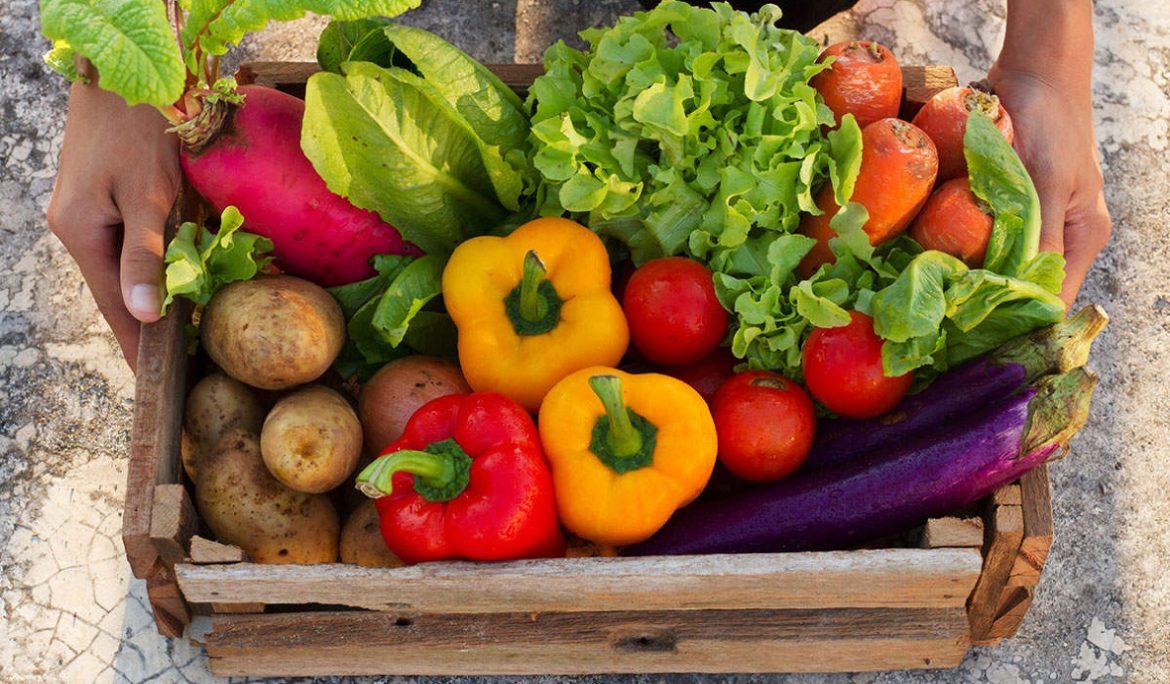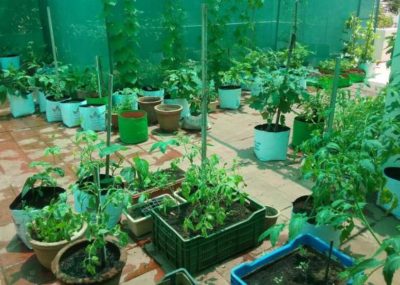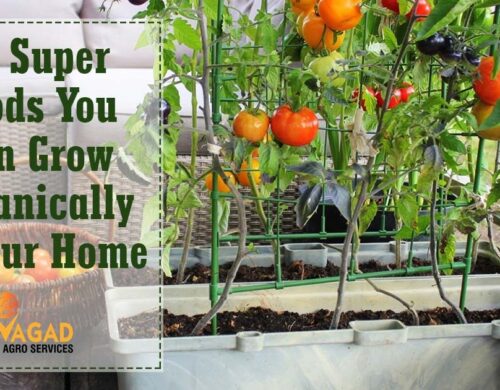
When we bought two flats on the top floor, we thought why not grow vegetables together so that our families can get organic vegetables. After this, in February last year, we built a permanent bed on our roof in about 40 square yards of land. All together cement, soil, laborers, etc., cost about 35 thousand rupees. To avoid dampness in the house, to put a brick on the roof, put small tiles. In the beginning, we kept a gardener to grow vegetables, but now we take care of the plants ourselves after the children go to school.

There are about 8-9 people in both families, including older and children. For all of us, 4 days a week in the peak season, vegetables are arranged from our terrace. However these days, due to extreme cold, vegetables are not available. We only supply insecticides for our plants from the market. The rest of the organic manure is prepared by itself, with the peels of fruits and vegetables and leftovers. If we give an average of two-and-a-half hours in a week for weeding, weeding, pouring water, etc., it is enough. One of the best methods for vegetable farming is a kitchen garden. It is the process of growing fruits and vegetables in the backyard of the house.
How To Prepare The Soil?
The preparation of flower beds or pots should be done by the end of September and the beginning of February. This is the right time for sowing.
You can buy soil from the fields or even from the park etc. If there are insects in the soil, then add vermicompost. While preparing the soil, keep 2 parts of soil, 1 part of dry manure of cow dung, and 1 part of dry leaves. Mix them well. Add a little bit of sand as well. Mix the prepared soil thoroughly and fill it in the bed. Keep the bed empty about 15 cm from the top. Similarly, prepare the pots.
Put broken pieces of pot or small stones in the bottom of the pot before filling the prepared soil in the pots, so that the soil is not nourished with water. One-third of the pot should remain empty so that the soil and manure do not flow out from the top when water is poured into it.
Then plant seeds in the soil. Whenever planting a seed, put it under the soil layer twice its size, otherwise, it will take a long time for the sprout to grow and it will take weeks for the spring to grow. After adding soil add light water. After this, cover the pots with paper so that the birds cannot remove the seeds. Remove the paper after sprouting. If the plants are to be planted in another pot, then transfer in the evening or at night, ie at the coldest time and then when the plants have 4-6 leaves.
Where To Seed?
To grow fruits or vegetables, always use natural breeding seeds and not hybrid seeds. Seeds can be purchased from the neighboring nursery or seed shop but it is better to take them from a government institution or a place that is known for good seeds, such as Pusa Institute in Delhi and Krishi Bhavan.
Once you start the kitchen garden method, you can grow all the vegetables like onion, potato, beans, cabbage, capsicum.
Plants of fruits like mango, banana, guava, lemon, peach, pineapple can also be planted in a drum of 70×70 cm. They come to fruits in about 3 years.
For fruitful plants, you will need their budding plant. Such varieties of guava and mango will also be found in the market, which is small in size but gives plenty of fruit.
Selection of Vegetables
Summer: Bitter gourd, lady finger, ghee, zucchini, tienda, cowpea, cucumber, etc. Apply cucumber and brinjal till the end of January, while the rest of the vegetables should be planted in February-March.
Winter: Radish, carrot, tomato, cabbage, cabbage, spinach, fenugreek, garlic, brinjal, peas, etc. All these vegetables are planted in October, November.
Medicinal plants like Aloe vera, Mint, Tulsi, and basil are grown in the Kitchen garden
How Much Water, How Much Sunlight Is Necessary?
In the Residential Kitchen garden, Sunlight is very important for any plant. This rule also applies to vegetable plants. It is necessary to sunlight the seeds while sprouting. If they do not do this, they will remain small and weak in size. 3-4 hours of sunshine daily is enough but protects the plants from the harsh afternoon heat in summer. For this, it is better to make a mesh shed on top of the plants.
Oxygen present in the soil particles cannot reach the roots of the plants due to excess water, so when the pots become dry, add water only. Take care of the weather too. Watering should be done every fourth-fifth day in winter and every other day in summer. There is no need to water the plants with rain and the next day. Water should be given only in the morning or in the evening. Do not forget to add water to plants under strong sunlight. Due to this, there is a risk of scorching plants.
If for some reason the plants have to be left alone and go outside for a few days, then fill the water in their pots with water. Put the pots in a tub in summer, fill some water in the tub as well. If you are going out of the house for 10-15 days, then before leaving, spread water by planting the pot or leech/moss. This will keep the moisture in the plants for a long time.
The size and shape of vegetables also play an important role in the kitchen garden-like how the number of persons in the family and how much will the time spare available for its care. Different types of implements used in kitchen garden are Spade, Pick Axe, Hand sprayer, and rode can.
How Much Fertilizer To Apply?
No plant needs much compost. Usually, fertilizer is applied when planting saplings and when they come to fruit or flower. Manure should always be organic. This manure is made from organisms, such as cow dung manure, manure made from feces and urine of animals and humans, etc. They do not contain harmful chemicals.
Neem, mustard, or groundnut cake is also used as manure. They are high in protein. Organic fertilizer packets are available from a good nursery. It is usually available in the range of 40 to 80 rupees per kg. The organic method of plant protection like Neem oil, Neem seed kernel seed extract is used in the kitchen garden.
Prepare Your Own Compost
Mix an equal amount of compost, red soil, sand, and cow dung. If there is a place, dig a deep pit in the raw ground, otherwise, take a big earthen pot. Put a thick layer of soil under it. On top of this put soft peels and pulp of vegetables and fruits coming out of the kitchen waste. If this waste is very wet, then put dry leaves or newspaper on top of it. Put a thick layer of soil over it and cover it. Keep doing this till you fill the pit or flowerpot. Wait until the mixture is reduced by one-third. It takes about 3 months. Now take out this manure and press it between the layers of soil in another pot and cover it with dry leaves. This fertilizer will be fully ready for use in 15 to 20 days. Use it to grow vegetables and fruits mixed with soil.
Repeat The Process Of Composting In An Empty Pit Or Pot.
Mustard cake from the market. To put the cake in the plants. Plants soak a cake in water in such a way that it should be prepared as a thick paste the next day. Mix this paste well in the soil and pour it into your pots. The ratio of soil and cake should be added in 1 kg cake in 10 kg soil. After pouring it into the pot, make mud of soil so that the soiled soil mixes with the pot. We also have to maintain the Residential kitchen garden with some of the factors like we have to grow the plants on the fence by training and we have to dump all kitchen waste in the manure pit and maintain it in wet condition.
How To Deal With Insects in Kitchen Garden?
You can prepare worms medicine yourself. Take an equal quantity of cow milk, lassi made from cow’s milk. Then grind a few neem leaves, mud leaves, and datura seeds into it. Leave 15-20 days in winter and one week in summer. Then filter and fill in the spray bottle. Take one part medicine and 50 parts water. Then spray on the plants. Apart from killing insects, this medicine also removes fungus.
It is fact that everyone needs a small organic vegetable farm, the kitchen garden at home it is difficult to get fresh vegetables throughout the year from your kitchen garden. Vagad Agro Services is Ahmedabad Gujarat-based agriculture services providing company that installs protected structures for the residential mini vegetable farm at home open space or on terrace. If you are growing vegetables in net protected structure then it is possible to get fresh & insect-free vegetables throughout the year from your kitchen garden. The protected kitchen garden structure protects plants from more sunlight, winds, insects, animals, and heavy rainfall.
Kalpesh Pathak
Related Posts

10 Super Foods You Can Grow Organically in Your Home Kitchen Garden
Organic farming is a approach of sustainable farming and these days ‘Organic Farming’ or ‘Organic Gardening’ or “Organic Kitchen Garden” is...

Benefits of eating seasonal Fruits & List of seasonal fruits
Access to fruits and vegetables is readily available year-round, but it's often recommended to consume seasonal produce. This idea is...
